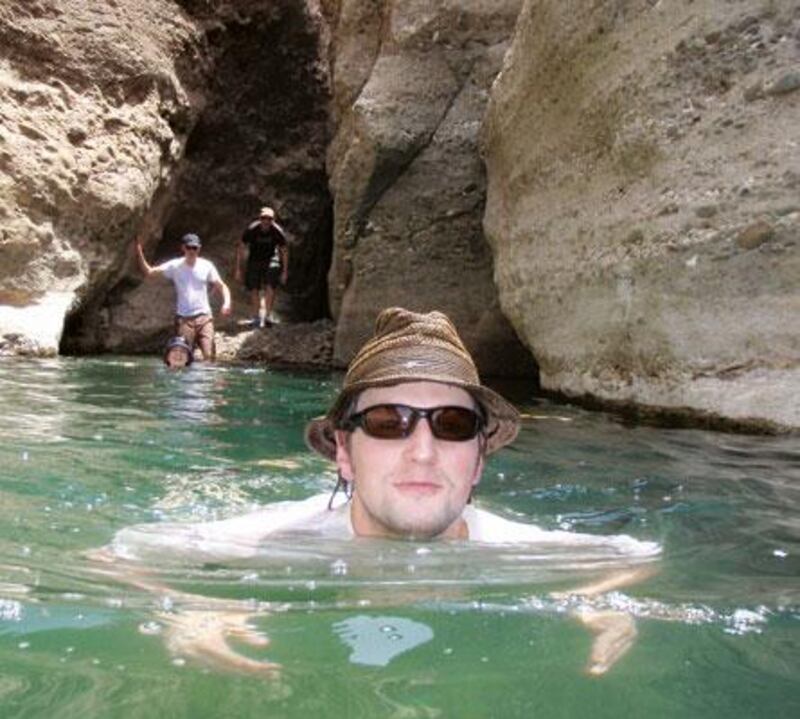Even at the height of a fierce Gulf summer, the chilly canyons and deep green waters of Hatta Pools are a haven of cool refreshment. In search of some respite from the baking city heat, John Henzell and friends explore one of the region's most surprising. This is better than the air conditioning in my office," Jenny says, halfway through the second canyon. Outside is the all-too-familiar baking heat of an Arabian summer, but here in the depths of a gorge, which never sees the sun, the temperature remains at a level that is not just comfortable but even a little chilly. This had seemed an impossible prospect only a few hours earlier, when we arrived at Hatta Pools, just over the Oman border from Hatta township, and found a wide, dusty wadi shimmering in the heat. I had told the others that this was one place where it was feasible to be outside at this time of year - I could tell they thought I was raving.
But as we drive and then walk down towards where a band of bedrock crosses the wadi, a tiny stream emerges from the gravel then disappears into a groove worn into the rock over millennia. We follow, trying to avoid touching the uncomfortably hot canyon walls as we wade through tepid, knee-deep water. Over the next 100 metres or so, the canyon progressively narrows from a couple of metres wide to shoulder width. Above, the walls tower over us, the water increases to thigh depth and we find ourselves having to help each other to clamber over obstacles as the stream cuts into the rock.
And, with the sun only briefly reaching the bottom of the canyon each day when the angle is right, the temperature becomes noticeably cooler. Then we turn a corner and are confronted with a deep pool of green water extending further than we can see. With a shrug of the shoulders, the walkers become swimmers. The water temperature is perfect - warm enough so we don't mind going beyond the psychological barrier of thigh depth, but not so warm that you can feel yourself sweating underwater.
"It's like nothing," says Georg. "It's like you can't feel it as you go into the water." There are the inevitable bits of flotsam, just a few plastic bottles - not the disposable nappies I'd heard previous visitors had encountered. Still, the green hue of the water suggests it would be wise to keep our mouths firmly shut as we set off on the slightly disconcerting process of paddling towards the unseen end of the canyon.
As we emerge at the end of the canyon a minute or so later, we startle a group of Omanis who have gathered on a Saturday morning to take turns doing dive-bombs into the pools. Their increasingly spectacular methods merely serve to confirm all known stereotypes about young men. For the next section of the hike it's back to a wide and dry wadi bed but, just beyond, the trunk of a dead date palm marks the start of the second part of the canyon, which is reportedly much less travelled, cleaner and nicer than the first section. I'd also been told that the start was more difficult than anything we would have encountered so far, and so it proves as the stream reappears from the gravel wadi bed near the date palm and then immediately plunges down through the bedrock in a series of increasingly large steps to a pool six metres below.
We'd brought a 30-metre rope and set it up as a handline, but it's more of a psychological prop as we slither and then finally jump about two metres into a waist-deep pool. We leave the rope in place as an insurance policy, in case we have to retrace our route. Having that Plan B makes it much easier to enjoy the unknown surprises ahead in the rest of the canyon, which immediately narrows again and deepens to maybe two metres as it snakes its way between sheer walls of rock.
We needn't have worried. Once through the constriction, the canyon begins to widen again and the pool becomes increasingly shallow until it peters out entirely as the stream returns to flowing underground through the gravel. Above us, the walls of the canyon begin to overhang until they meet in a huge arch above us. It is clear the sun never reaches in here, and the thermal mass of the stone walls keeps the temperatures cool enough that it works, as Jenny observed, better than air conditioning.
Even without the water, the canyon maintains its interest, and we find ourselves having to clamber over the remains of an ancient landslide, then squeeze our way through a narrow cave in an inverted V-shape, finally emerging at another pool. This one is much shorter than the first and then the gorge opens up into a broad, rocky wadi bed that quickly demonstrates to us that, while we were swimming and slithering through the canyon, the sun had been beating down as relentlessly as ever.
After about two and a half hours in the otherworldliness of an environment that was both pleasant and not air conditioned, we return to the more typical Gulf summer temperatures for the 1.5km walk back to the start. By the time we reach the cars, after maybe 15 minutes or so later, my shirt and shorts are already dry and we crank the air conditioning on high. The car's thermometer is showing 50°C. It's back to business as usual in the searing summer heat.
There are no commercial canyoning trips running through Hatta Pools, although Brian Goggins of Dubai-based Leadership and Management Development Associates takes clients through the two gorges as part of LAMDA's wider corporate-training business and can provide information. Call 050 447 2854 for details.





